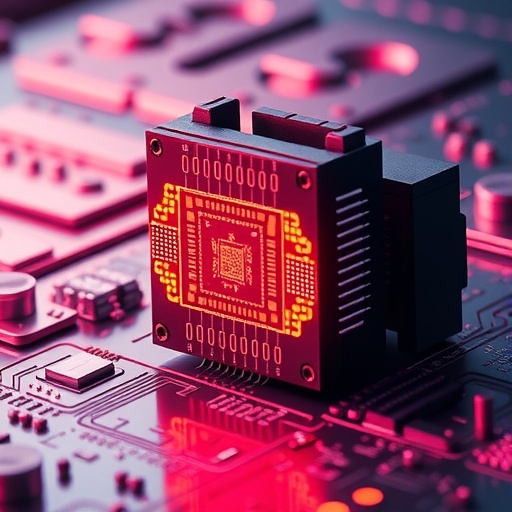Revolutionizing Semiconductor Manufacturing: AI-Powered Inverse Lithography Technology Ushers a New Era in Chip Fabrication
The semiconductor industry stands at the forefront of technological innovation, continually pushing the boundaries of what is possible in electronic device manufacturing. At the heart of this relentless pursuit lies lithography—the pivotal process that fabricates the intricate patterns of integrated circuits on silicon wafers. As device dimensions continue to shrink exponentially following Moore’s Law, lithography faces increasingly daunting challenges. Traditional methods of improving resolution by shortening exposure wavelengths or increasing the numerical aperture of lithography systems have now approached fundamental physical and economic limits. This bottleneck has sparked a paradigm shift towards computational lithography, where algorithmic and data-driven approaches optimize lithographic processes to enhance pattern fidelity beyond conventional constraints.
Central to computational lithography is inverse lithography technology (ILT), an innovative method that applies global optimization frameworks to design photomasks capable of producing target wafer patterns with unprecedented precision. Unlike forward modeling—which predicts outcomes from known mask patterns—ILT formulates the problem inversely, starting from a desired wafer image and computing the optimal mask that will yield that pattern under the lithographic process. Originally conceptualized in 1981 by University of Wisconsin-Madison researchers and commercialized in the early 2000s, ILT has since undergone successive waves of refinement. These advances include the introduction of regularization strategies and conjugate gradient optimization algorithms that dramatically improved computational efficiency, alongside hardware acceleration using graphics processing units (GPUs).
Recent breakthroughs have propelled ILT into a new era through the integration of artificial intelligence (AI), as chronicled in a comprehensive review by a Tsinghua University research team in the journal Light: Science & Applications. This landmark review, authored by Ph.D. candidate Yixin Yang and led by Professor Liangcai Cao, elucidates how AI techniques—spanning deep learning frameworks like convolutional neural networks (CNNs) and generative adversarial networks (GANs)—have revolutionized lithography modeling and mask optimization. These intelligent systems bridge traditional physics-based models with data-driven approaches, enabling highly accurate simulation of complex lithographic phenomena such as near-field diffraction, resist chemistry effects, and extreme ultraviolet (EUV) exposure at unprecedented speeds and scales.
The lithography process itself consists of multiple intricate stages, beginning with photoresist coating and pre-baking, followed by exposure through mask projection, post-exposure baking, development, etching, and finally resist stripping. Each step must be meticulously controlled to realize feature sizes measuring mere nanometers. Over decades, lithography tools transitioned from contact and proximity methods, which suffered from mask contamination and wafer flatness issues, to sophisticated projection lithography machines introduced in the 1970s. These systems project mask patterns optically onto wafers, now augmented with resolution enhancement techniques (RETs) such as off-axis illumination, optical proximity correction, and phase-shift masks. Computational lithography models these complexities and iteratively fine-tunes mask designs and illumination conditions to counteract optical distortions and process variations.
AI integration into ILT systematically addresses these bottlenecks by harnessing advanced neural network architectures to emulate complex lithographic simulations with speed and accuracy unmatched by physics-only models. Data-driven frameworks reduce the trade-off between computational efficiency and predictive fidelity by learning intricate mappings from million-scale datasets of mask patterns and resultant wafer images. Hybrid models that fuse physical constraints with learned representations uphold the interpretability and physical consistency vital for industrial acceptance while leveraging the generalization strength of AI. Generative models streamline mask pattern synthesis, and graph neural networks adeptly manage layout design rules and constraints, facilitating holistic source-mask co-optimization.
Despite these transformative advances, key challenges persist. Improving computational efficiency to enable full-chip ILT optimization without subdivision artifacts remains a pressing goal. Partitioning large layouts into smaller units currently introduces boundary stitching errors that degrade pattern consistency. In mask fabrication, technological hurdles in multi-beam mask writing (MBMW) and EBDW must be surmounted to realize the intricate curvilinear mask geometries designed by ILT, enhancing throughput while maintaining resolution. Furthermore, AI models’ reliance on extensive labeled training data and limited interpretability calls for more transparent physics-embedded algorithms and automated workflows to reduce dependency on manual intervention and expert curation.
Looking into the horizon, the fusion of AI-driven computational lithography with next-generation mask manufacturing technologies promises to usher in a new era for semiconductor fabrication. Accelerated GPU computing and physics-informed deep learning are set to propel ILT from niche hotspot correction to comprehensive full-chip optimization. The maturation of MBMW will enable rapid fabrication of complex mask patterns, bridging the gap between computational design and physical realization. Innovations in multi-scale modeling frameworks integrating quantum-scale phenomena with macroscopic process variations will refine predictive accuracy. Collectively, these developments will catalyze the production of integrated circuits with ever-smaller nodes, unlocking performance and energy efficiency gains critical for emerging applications in artificial intelligence, 5G communications, and beyond.
The review by the Tsinghua team vividly illustrates that ILT’s trajectory—from theoretical concept to indispensable industry tool—embodies a broader narrative of how AI is reshaping semiconductor manufacturing. This symbiotic relationship between computational innovation and hardware capability underpins the continuous advancement of the electronics ecosystem. As ILT methodologies mature and AI-powered lithography software proliferates, the once rigid constraints of classical optics and material science will yield to more agile, intelligent, and scalable solutions. The semiconductor industry stands ready on this cusp, poised to drive the next wave of technological revolutions that will define the digital age.
Subject of Research: Inverse lithography technology enhanced by artificial intelligence for semiconductor manufacturing.
Article Title: Advancements and challenges in inverse lithography technology: a review of artificial intelligence-based approaches
News Publication Date: Information not specified in the source material.
Web References: DOI: 10.1038/s41377-025-01923-w
Image Credits: Yang, Y., Liu, K., Gao, Y. et al., Light: Science & Applications
Keywords: Inverse lithography technology, computational lithography, artificial intelligence, semiconductor manufacturing, mask optimization, deep learning, photolithography, resolution enhancement, electron-beam direct writing, GPU acceleration, multi-beam mask writing
Tags: AI-powered lithography technologyalgorithmic approaches in lithographychallenges in lithography resolutionchip fabrication technologiescomputational lithography advancementsfuture of electronic device manufacturingglobal optimization in photomask designinverse lithography techniquesMoore’s Law implicationsoptimization in semiconductor processespattern fidelity in chip designsemiconductor manufacturing innovations





